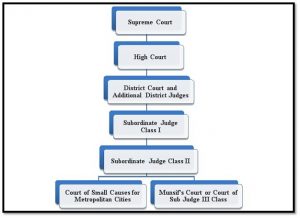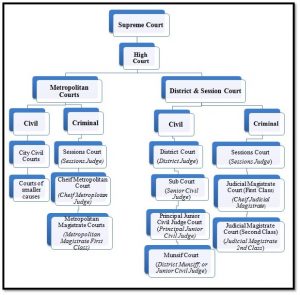By: Muskan Sharma
Concept of Plea Bargaining
Plea Bargaining is a process where the accused is asked to plead guilty in exchange of the judge acting lenient while awarding punishment or considering the seriousness of the offence. It is derived from the Latin phrase ‘Nolo Contendere’ which means ‘I do not wish to contend’ i.e. a plea of ‘No contest’. Plea Bargaining is a situation where the accused admits that the charges levelled against him are true and that he will not contend a query to the Court to decide over his guilt.
The concept of Plea Bargaining was not originally introduced into the Indian legal system but into USA. However, the Law Commission’s efforts promoted the insertion of the provisions concerning Plea Bargaining via its 142nd, 154th, and 177th reports. A new chapter on ‘Plea Bargaining’ was introduced into the Criminal Procedure Code based on the recommendations of the Law Commission for certain offences.
There are three types of Plea Bargaining namely, Sentence Bargaining, Charge Bargaining, and Fact Bargaining.
The concept of ‘Plea Bargaining’ is operative in both India and USA but the practice is not identical. However, it is pertinent to know about the concept of Plea Bargaining and landmark cases associated to it in both legal systems separately for a fruitful comparison between the two.
Learn more about Criminal Laws with Enhelion’s Online Law firm certified Master Course!
Plea Bargaining in USA
In USA, the accused can put forward one of the three pleas i.e. Guilty, Not Guilty, and Nolo Contendere. Under the doctrine of Nolo Contendere, the plea is treated as an implied confession of guilt or that the Court will decide on the point of his guilt.
However, the Court is not bound to accept such a plea of the accused. It is the discretionary power of the Court to either accept or reject such plea, considering the facts and circumstances of each case presented to it. The Court is supposed to ensure that the plea should be put forward voluntarily by the accused and absence of duress and coercion. The accused must receive the protection of secrecy. Plea Bargaining gained momentum due to the overcrowding in prisons of USA.
Landmark Cases in USA
- State exrel Clark Adams[1]
In the instant case, the Court explained the doctrine of ‘Nolo Contendere’. The Court held that the plea of ‘Nolo Contendere’ also known as ‘Plea of Nolvut’ means the accused does not wish to contend.
- United States Risfield[2]
The Court observed that in a criminal action in which an application for Plea Bargaining has been made, the adjudication by the Court in relation to the plea of guilty is not necessary. However, the Court may impose sentence on the accused person immediately.
- Lott United States[3]
The Court held that the plea being tantamount to an admission of guilt, is not conviction but merely a determination of guilt.
- Bordenkircher Haynes[4]
In this case, the US Supreme Court upheld the constitutionality of Plea Bargaining while awarding life imprisonment to the accused person who rejected to plead guilty for imprisonment for a term of five years. The Supreme Court observed a slight possibility that the accused person may be coerced to choose among the lesser of the two punishments.
The Supreme Court further observed that there is no probability of coercion or duress if the accused person is free to either accept or reject the offer made by the prosecutor during the negotiation process for Plea Bargaining.
- Brady United States[5]
In the instant case, the Supreme Court held that the consensus reached out of fear that the trial will result into death penalty will not make the process of Plea Bargaining illegitimate. If the process of Plea Bargaining has been properly conducted and controlled, it is legitimate.
Learn more about Criminal Laws with Enhelion’s Online Law firm certified Master Course!
Plea Bargaining in India
Section 265A to 265L (Chapter XXI A) of the Criminal Procedure Code, 1973 (hereinafter referred to as “CrPC”) contain provisions concerning ‘Plea Bargaining’.
Section 265A of CrPC provides who is eligible to take benefit of Plea Bargaining. According to the provisions of Section 265A, any accused may take the course of Plea Bargaining except the accused charged with offences that are punishable with death or life imprisonment or imprisonment for a term more than seven years. Also, an accused charged with an offence against a woman or a child below fourteen years of age or affecting the socio-economic conditions of the country, is also not allowed to take the course of Plea Bargaining.
Section 265B provides for the procedure to file an application for Plea Bargaining. The application must contain all details of the case accompanied by a sworn affidavit. Afterwards, the Court may examine the accused to satisfy itself of the fact that the accused has filed such application voluntarily. If the accused satisfies the Court of the voluntariness, the Court provides some time for the mutual satisfactory disposition of the case. If in case, the accused fails to satisfy the Court that he has filed the application voluntarily or that he has been convicted with the same offence previously, the Court may proceed from the stage the application has been filed before it.
Section 265C contains guidelines for mutually satisfactory disposition of the case. It states that the Court shall issue notice to the public prosecutor, if the case instituted on a police report, the accused, and the victim to participate in a meeting to reach at a satisfactory disposition of the case. However, the Court must ensure that the process be completed voluntarily and the accused may participate with his pleader, if he desires so.
Section 265D to Section 265I contain provisions concerning the report of mutually satisfactory disposition, disposal of the case, judgment of the Court, finality of the judgment, power of the Court in plea bargaining, and period of detention already undergone by the accused be set off against the sentence of imprisonment.
Landmark Cases in India
- Murlidhar Meghraj Loya State of Maharashtra[6]
In the instant case, J. Krishna Iyer criticized the practice of Plea Bargaining. He observed that the Trial Magistrate is burdened with cases and hence, approves the secret dealings of Plea Bargaining. He further observed, “The businessman culprit, confronted by a sure prospect of the agony and ignominy of tenancy of a prison cell, ‘trades out‘ of the situation, the bargain being a plea of guilt, coupled with a promise of ‘no jail‘. These advance arrangements please everyone except the distant victim, the silent society…”
- Kachhia Patel Shantilal Koderlal State of Gujarat and Anr.[7]
In this case as well, the Supreme Court criticized the concept of Plea Bargaining. The Court held that Plea Bargaining is an unconstitutional process as it encourages corruption and pollutes the concept of justice.
- State of Uttar Pradesh Chandrika[8]
The Supreme Court held that it is a settled law that a criminal case cannot be disposed off merely on the basis of Plea Bargaining. It was further observed that it is the constitutional duty of the Court to consider the merits of the case and award appropriate sentence despite the confession of the guilt by the accused person. Mere confession of the guilt by the accused person cannot be a reason for awarding lesser punishment.
However, there has been a shift in the judicial thinking with the passage of time.
Learn more about Criminal Laws with Enhelion’s Online Law firm certified Master Course!
- State of Gujarat Natwar Harchandji Thakor[9]
In the instant case, the Gujarat High Court favoured the process of Plea Bargaining and held that the object is to provide easy, cheap, and expeditious resolution of disputes including the trial in criminal cases and that it prevents the pendency and delay in disposal of the administration of justice.
- Vijay Moses Das CBI[10]
In the instant case, a person was accused of supplying of sub-standardized material to ONGC at a wrong port and thereby, causing ONGC to suffer huge losses. CBI completed the investigation and started prosecution against the accused person under Section 420, 468, and 471 of the Indian Penal Code, 1860. The accused person took the course of Plea Bargaining. But the Trial Court rejected the application of Plea Bargaining on the ground that it was not accompanied by an affidavit as stipulated under Section 265B and no compensation was fixed. However, the Uttarakhand High Court directed the Trial Court to accept the application of Plea Bargaining.
- Thippaswamy State of Karnataka[11]
In the instant case, the Supreme Court held that inducing an accused person to plead guilty under any assurance or promise is unconstitutional for being violative of Article 21 of the Indian Constitution. It further observed that in such cases, the Court must set aside the conviction and direct the case to the Trial Court to give accused person the right to defend himself and if found guilty, the Trial Court may award appropriate punishment to him.
Plea Bargaining in India and USA: Comparative Analysis
Though the concept of ‘Plea Bargaining’ as adopted into the Indian legal system has been borrowed from USA, it is still distinguishable from the operation of ‘Plea Bargaining’ in USA. Following are some of the major differences that exist between the concept of ‘Plea Bargaining’ as operative in India and USA:
Learn more about Criminal Laws with Enhelion’s Online Law firm certified Master Course!
- Nature of Offence
In USA, there is no provision as to the prohibition on plea bargaining in certain offences. An accused person charged with any offence may take the course of Plea Bargaining. However, in India, there are exceptions as contained in Section 265A. Following categories of accused persons cannot take the course of Plea Bargaining in India:
- Accused person charged with an offence punishable with death
- Accused person charged with an offence punishable with life imprisonment
- Accused person charged with an offence punishable with imprisonment of more than seven years
- Accused person charged with an offence against women
- Accused person charged with an offence against a child below fourteen years of age
- Accused person charged with an offence that affects socio-economic conditions of the country
- Role of Victim in Proceedings
In Indian Law, the victim has an important role in the proceedings of Plea Bargaining. The victim has the power to refuse or veto if unable to reach a mutually satisfactory disposition. However, in USA, the victim does not have an active role to play in the proceedings of Plea Bargaining.
- Mechanisms available for enforceability
In USA, an application for Plea Bargaining is filed only after the negotiation process between the accused person and the prosecutor is complete. However, in India, the negotiation process with the accused person does not even start before the filing of the application of the Plea Bargaining to ensure that the application of Plea Bargaining is filed voluntarily by the accused. Therefore, there is less chance of the accused being coerced or secret dealings for filing an application for Plea Bargaining.
Learn more about Criminal Laws with Enhelion’s Online Law firm certified Master Course!
- Discretion of the Judge
In USA, the judge does not exercise discretionary power while accepting an application for Plea Bargaining. However, in Indian legal system, the judge has discretionary powers to either reject or accept an application for Plea Bargaining filed by the accused person.
- Finality
Under the Indian legal system, if the Court thinks the punishment awarded in any case of Plea Bargaining is insufficient or is guarded by unfair circumstances, it may be set aside either by an SLP under Article 136 or a writ petition under Articles 226 and 227 of the Indian Constitution. However, in USA, it reaches its finality.
Conclusion
The conviction rate via Plea Bargaining in the USA is as high as nearly 90% whereas in India, it is not even close to 10% of the criminal cases. This disparity exists due to the differences that exist between the concept of Plea Bargaining as practiced in USA and India.
Though the conviction rate in India is way too low as compared to the conviction rate in USA, it is effective in ensuring that the application of Plea Bargaining has been filed voluntarily. Justice may be delayed but must not be denied. In India, an accused person does not take the course of Plea Bargaining to choose the lesser among the punishments but is a voluntary action. Hence, it is high probability that an innocent person will not be awarded punishment in India by way of Plea Bargaining.
However, speedy disposal of cases is the need of the hour. Hence, the legislature must go for reforms and provide adequate infrastructure to the judiciary to reduce the number of undertrial prisoners.
Learn more about Criminal Laws with Enhelion’s Online Law firm certified Master Course!
[1] 363 US 807
[2] 340 US 914
[3] 367 US 421
[4] 434 US 357 (1978)
[5] 397 US 742 (1970)
[6] AIR 1976 SC 1929
[7] 1980 Cr LJ 553
[8] 2000 Cr LJ 384
[9] (2005) Cr LJ 2957
[10] Crl. (Misc.) Application No. 1037/2006
[11] (1983) 1 SCC 194


